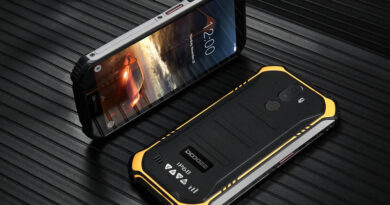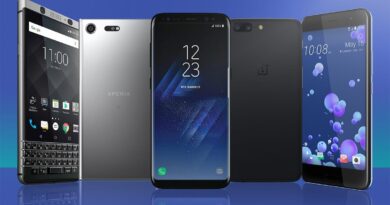5 best smartphones with dual cameras
Smartphones diligently take work away from cameras. Until recently, the phone could take simply readable and watchable photographs, and now it surpasses the quality of the work of a “soap dish”, and sometimes even a professional camera. And the defective optical system in the smartphone's camera is compensated by software processing and automatic intelligent "enhancement" of frames.
Smartphone manufacturers are making full use of the new trend - dual-camera. They install two camera modules in the device, allowing you to get the bokeh effect in the photo, improve the quality characteristics and achieve background blur.
Dual cameras work like this. For example, Apple installs modules with different focal lengths. Such a system zooms the frame using optics. The notorious portrait mode operates on this principle: the camera focuses exclusively on the model, ignoring the background, then takes a picture and programmatically brings beauty, beautifully blurring the background.
Huawei has approached even more unusual: it equips its phones with two modules, one of which works in monochrome. By capturing a frame in black and white, the camera is more sensitive to light and produces better images in low light conditions. By superimposing a color image from a second, conventional, camera on top, the user gets a juicy high-quality photo.
There is one caveat - the presence of two cameras in a smartphone does not mean its excellent photographic capabilities. The cunning Chinese of the third echelon often supplement their devices with a second dummy module with a minimum resolution, which does not improve the images in any way. Therefore, we have compiled a selection of the best smartphones with a dual camera, which will definitely delight you with the resulting shots.
Top 5 best dual camera smartphones
5 Xiaomi Mi A1

A pure Android smartphone from Xiaomi has become an unspoken hit among budget phones with a dual camera. There are two color modules of 12 megapixels, 2x optical zoom and phase detection autofocus. One module with a telephoto lens, the other with a wide-angle lens. The portrait mode is present: in it, the system smears the background and focuses exclusively on the subject, simulating the work of a professional camera. Sometimes a smart program has misfires - the hair and "protruding" parts of the body are washed out, the contours of the object may be out of focus.
The camera is capable of HDR and demonstrates a high-quality result. The program interface assumes access to a variety of manual settings: from contrast and exposure to the choice of an active camera module. Xiaomi Mi A1 can rightfully be considered the best cheap camera phone. Yes, there are flaws in the camera, but for such a price they are easy to forgive.
4 Nokia 8 Dual SIM

The flagship from the beloved by many Finnish company surprises with a dual camera and technologies implemented in the field of photography. The legendary optics of Zeiss AG are worthy of attention and respect. The process of creating a frame is as follows: the camera shoots with two modules at the same time, then superimposes the pictures on top of each other and programmatically improves them. In portrait mode, the system blurs the background nicely. It is a pity that there is no post-focusing function on an already finished shot.
The manufacturer focuses on the "Bozi" function: it is the ability to record video simultaneously on the main and front cameras. Another innovation from Nokia is video recording with sound on three microphones with the ability to focus on the sound source. In the viewfinder, you need to "tap" on the image of a sounding object, and now, no matter how you twist the phone, the microphones will diligently ignore other sounds and record waves from the designated source.
3 Apple iPhone 8 Plus

This underrated Apple smartphone boasts a dual camera with different apertures: f / 1.8 wide-angle and f / 2.8 telephoto. Both cameras are endowed with a resolution of 12 megapixels.Optical stabilization, alas, only in the wide-angle module. Compared to previous Apple creations, this phone features a new, faster image signal processor, expanded color range and instant autofocus. The flash has also undergone changes: the manufacturer has equipped it with the Slow Sync function, which means that the foreground and background are evenly illuminated. The camera can shoot in 4K format and creates high-quality videos. There is also a slowdown function, which was appreciated by instabloggers.
But the main pride of the owners of the eighth iPhone with a plus sign in the name is portrait photography with the effect of studio lighting. Now professional portraits can be created without special equipment, tripods, lamps and light diffusers.
2 Samsung Galaxy S9 +

This model has the fastest camera in the world. The minimum aperture size is f / 1.5. But that's not all - the aperture size can be adjusted according to the user's preference. Choose f / 1.5 for low-light or portrait shots with background blur, and f / 2.4 for sunny weather and landscapes. The resolution of both modules is 12 megapixels. Pleases the noise reduction system.
The shooting process is conventionally divided into three stages. First, a photosensitive matrix with Dual Pixel, a special autofocus system, is used. Next comes the high-speed signal processing system. The DRAM memory module is shutting down, which reads the image from the matrix and sends it for processing. Thanks to this division of labor, the smartphone is able to shoot in super slow motion in 4K quality. Users have appreciated the fun function of modifying the lights in the background. They can be programmatically shaped like hearts or asterisks. Well, cherry on the cake: both cameras work with optical stabilization.
1 Honor 9

This is a creation from a sub-brand of Huawei, which users love for the magical quality of the images. The main camera employs two modules - 20 and 12 megapixels. They are the ones who work wonders of photography, forcing users to stir up controversy about the nature of the picture - whether it was actually filmed with a smartphone.
One module is monochrome and shoots in black and white. The color module received a resolution of 12 megapixels, and the monochrome one got 20 megapixels. When photographing, both modules are involved - first, a monochrome image is obtained with a high-quality white balance, well-developed shadows and expressive light areas, then a color picture is superimposed on it, captured by another camera eye. The resulting photo is saved in a resolution of 20 MP.
In the camera application interface, you can choose which of the modules you want to use when shooting. Purely color images are obtained at 12MP resolution.



